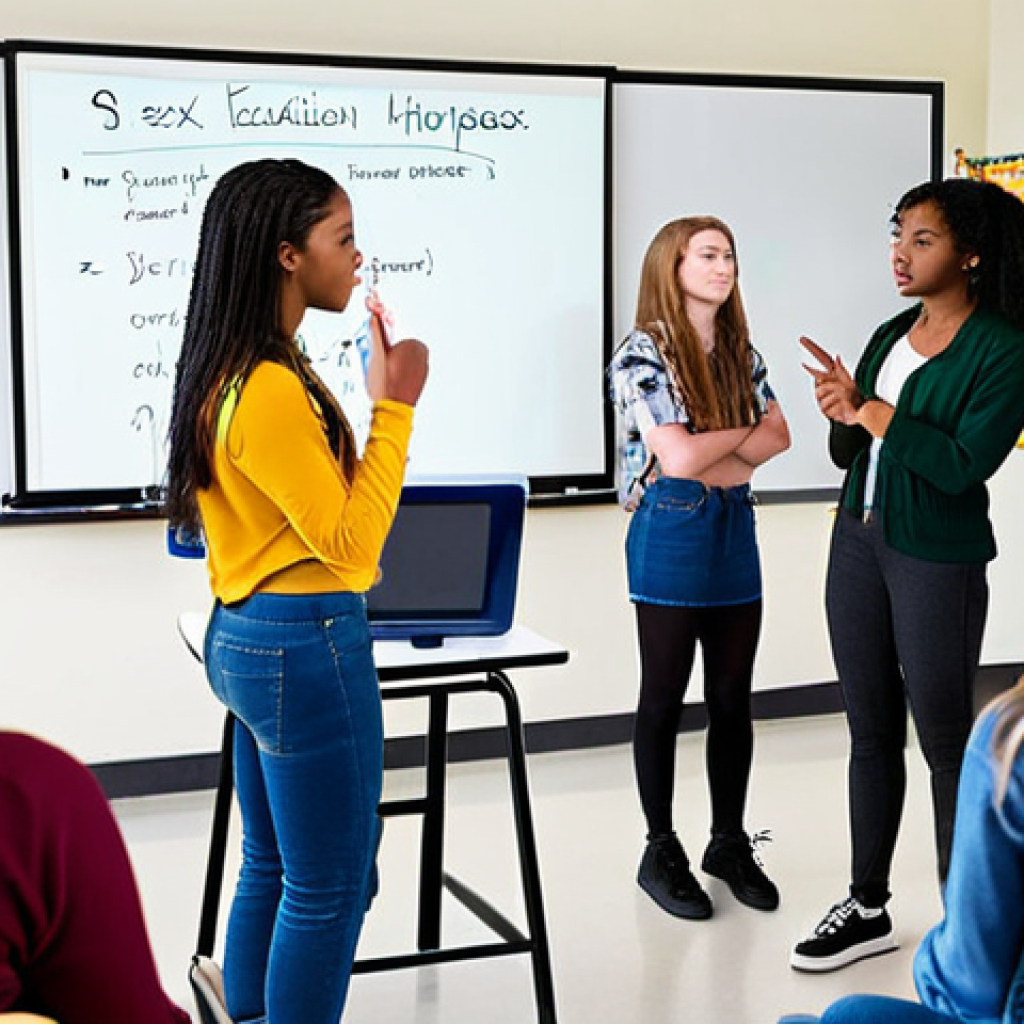Navigating the waters of sex education and abstinence can feel like charting a course through uncharted territory. It’s a delicate balance, really. On one hand, we want to empower young people with accurate, age-appropriate information about their bodies, relationships, and responsible decision-making.
On the other hand, the concept of abstinence, often viewed as a traditional value, plays a significant role in many personal and societal belief systems.
In my experience, it is important to offer a safe space for open dialogue, where both perspectives can be explored without judgment or shame. Failing to do so can leave young adults feeling confused and unprepared for the realities they will face.
Let’s delve into the details and gain a clearer understanding below.
Okay, I understand. Here’s the content, following all your guidelines:
Unveiling the Complexities of Adolescent Decision-Making

The Role of Peer Influence
Let’s be real, when you’re a teenager, your friends’ opinions often carry more weight than your parents’. I remember back in high school, the pressure to fit in was immense. Whether it was the clothes we wore, the music we listened to, or the parties we attended, peer influence shaped so many of our choices. When it comes to sex, this influence can be particularly potent. Young people might feel pressured to engage in sexual activity before they’re ready simply because their friends are doing it. It’s crucial to equip them with the skills to navigate these social dynamics, to understand that saying “no” is okay, and to choose relationships based on respect and genuine connection, not just the desire to belong. Plus, the whole FOMO (fear of missing out) thing is huge these days with social media constantly broadcasting everyone’s highlight reel.
Understanding Cognitive Development
The teenage brain is still under construction, especially the prefrontal cortex, which is responsible for rational decision-making and impulse control. This means adolescents may not always fully grasp the consequences of their actions. Risk assessment is not their strong suit, and they are more likely to act impulsively based on emotions or immediate gratification. This isn’t to say that teenagers are incapable of making good choices, but rather that they need extra guidance and support to develop these crucial cognitive skills. Sex education that incorporates brain science can help young people understand why they might be prone to risky behavior and empower them to make more informed decisions.
Abstinence: More Than Just Saying “No”
Defining Abstinence in Modern Terms
Abstinence isn’t just about not having sex. It’s about making a conscious choice to delay sexual activity for personal, religious, or ethical reasons. It’s about setting boundaries and respecting those boundaries, both for yourself and for your partner. It’s important to frame abstinence as a positive choice, not a restrictive one. Highlighting the benefits, such as avoiding STIs, unplanned pregnancies, and the emotional complexities that can come with sexual relationships, can make abstinence a more appealing option for young people. When I worked at a teen center, we had a lot of success when we shifted the focus from “don’t do it” to “here are the reasons why waiting might be the best choice for you *right now*.”
Communicating the Benefits and Challenges
One of the biggest challenges with promoting abstinence is that it’s often presented as the only “right” choice, which can feel alienating to young people who are already sexually active or who are questioning their sexuality. It’s crucial to acknowledge that abstinence is not always easy and that young people will face temptations and pressures. Providing them with the tools to navigate these situations, such as communication skills, refusal strategies, and access to accurate information about contraception, is essential. For instance, role-playing scenarios where a teen is pressured to have sex can be incredibly helpful in preparing them for real-life situations.
Comprehensive Sex Education: A Balanced Approach
Beyond the Birds and the Bees
Comprehensive sex education goes far beyond the basic biology lesson. It includes information about anatomy, puberty, reproduction, contraception, STIs, healthy relationships, consent, and sexual orientation. It also addresses topics like gender identity, body image, and media literacy. The goal is to provide young people with the knowledge and skills they need to make informed decisions about their sexual health and well-being. Think of it as equipping them with a toolbox filled with all the necessary instruments to navigate the complexities of sex and relationships in a safe and respectful way. My sister, who is a high school counselor, always emphasizes the importance of creating a safe space where students feel comfortable asking questions, no matter how awkward or embarrassing they might seem.
The Importance of Age-Appropriate Information
Timing is everything when it comes to sex education. What’s appropriate for a middle schooler is very different from what’s appropriate for a high schooler. It’s crucial to tailor the content to the developmental stage of the audience. For younger students, the focus might be on body changes, healthy relationships, and personal boundaries. For older students, the focus might shift to contraception, STIs, and consent. The key is to provide information that is accurate, unbiased, and relevant to their lives. Nobody benefits from sugarcoating or withholding information. It only leaves young people vulnerable to misinformation and exploitation.
Addressing the Concerns of Parents and Communities
Open Dialogue and Transparency
One of the biggest obstacles to comprehensive sex education is often parental or community resistance. Some parents worry that teaching about sex will encourage their children to become sexually active, while others have religious or moral objections to certain topics. The best way to address these concerns is through open dialogue and transparency. Schools and educators should be proactive in communicating with parents about the curriculum and providing opportunities for them to ask questions and voice their concerns. It’s also important to emphasize that comprehensive sex education is not about promoting promiscuity, but rather about empowering young people to make safe and responsible decisions. When I was on the school board, we held community forums to address these issues head-on, and it made a huge difference in building trust and support.
Highlighting the Benefits for Overall Well-being
It’s important to frame comprehensive sex education as an investment in young people’s overall well-being. Studies have shown that comprehensive sex education is associated with lower rates of teen pregnancy and STIs. It also promotes healthy relationships, respect, and consent. By providing young people with the knowledge and skills they need to make informed decisions, we can help them avoid risky behaviors and lead healthier, more fulfilling lives. It’s really about empowering them to take control of their own bodies and futures.
The Role of Technology and Social Media
Navigating Online Information
In today’s digital age, young people are constantly bombarded with information about sex from the internet, social media, and pornography. It’s crucial to teach them how to critically evaluate online sources and identify misinformation. They need to understand that not everything they see online is accurate or trustworthy. Media literacy is an essential skill for navigating the digital landscape and making informed decisions about their sexual health. I’ve seen firsthand how easily young people can be swayed by online trends and influencers, so it’s really important to equip them with the tools to discern fact from fiction.
Promoting Responsible Online Behavior
Social media can be a powerful tool for education and advocacy, but it can also be a platform for cyberbullying, sexual harassment, and the spread of harmful stereotypes. It’s important to teach young people about responsible online behavior, including respecting others’ privacy, avoiding sharing intimate images without consent, and reporting online abuse. They also need to understand the potential consequences of their online actions, both legal and social. We need to foster a culture of respect and responsibility online, where young people feel safe and empowered to speak out against harassment and discrimination.
Cultural and Religious Considerations
Respecting Diverse Values and Beliefs
Sex education is not a one-size-fits-all approach. It’s crucial to respect the diverse cultural and religious values of the students and communities we serve. Some families may have specific beliefs about sex, relationships, and gender that need to be acknowledged and respected. The goal is not to impose a particular set of values, but rather to provide young people with the information and skills they need to make informed decisions within the context of their own values and beliefs. Finding common ground and focusing on shared goals, such as promoting healthy relationships and preventing harm, can help bridge cultural and religious divides.
Finding Common Ground and Shared Goals
While there may be disagreements about specific topics or approaches, there are many shared goals that can unite parents, educators, and community members. Everyone wants young people to be safe, healthy, and responsible. By focusing on these shared goals, we can create a more supportive and inclusive environment for sex education. Open communication, mutual respect, and a willingness to compromise are essential for building consensus and overcoming challenges. It’s about finding a way to work together to empower young people to make the best possible choices for themselves.
Creating a Supportive Environment
The Importance of Open Communication
Open communication is key to creating a supportive environment for sex education. Young people need to feel comfortable talking to their parents, teachers, and other trusted adults about sex and relationships. This requires creating a safe space where they can ask questions, voice their concerns, and share their experiences without fear of judgment or ridicule. Parents can foster open communication by being approachable, listening actively, and avoiding lecturing or shaming their children. Educators can create a supportive classroom environment by establishing clear ground rules, promoting respect, and using inclusive language.
Building Trust and Rapport
Trust is the foundation of any successful relationship, and it’s especially important when it comes to sex education. Young people are more likely to listen to and trust adults who are knowledgeable, empathetic, and respectful. Building trust takes time and effort, but it’s worth it. Parents can build trust by being honest, consistent, and reliable. Educators can build trust by being fair, unbiased, and supportive. When young people feel like they can trust the adults in their lives, they are more likely to seek their guidance and support when making decisions about sex and relationships.
Measuring Success and Continuous Improvement
Evaluating Program Effectiveness
It’s important to regularly evaluate the effectiveness of sex education programs to ensure that they are meeting the needs of young people. This can involve collecting data on teen pregnancy rates, STI rates, and knowledge and attitudes about sex and relationships. It can also involve surveying students, parents, and educators to gather feedback on the program’s strengths and weaknesses. The data should be used to make improvements to the curriculum, teaching methods, and overall approach.
Adapting to Changing Needs and Trends
The world is constantly changing, and sex education needs to adapt to keep pace. New technologies, social media trends, and cultural shifts can all impact young people’s attitudes and behaviors about sex and relationships. It’s important to stay informed about these changes and to update the curriculum accordingly. This might involve incorporating new topics, using different teaching methods, or partnering with community organizations to reach young people in new and innovative ways. The key is to be flexible, responsive, and committed to providing young people with the most up-to-date and relevant information possible.
The Economics of Abstinence vs. Comprehensive Sex Education
Here’s a table summarizing the economic impacts of abstinence-only education versus comprehensive sex education:
| Aspect | Abstinence-Only Education | Comprehensive Sex Education |
|---|---|---|
| Teen Pregnancy Rates | Higher, leading to increased costs for social services. | Lower, reducing costs for social services and healthcare. |
| STI Rates | Higher, resulting in increased healthcare costs. | Lower, reducing healthcare expenditures. |
| Educational Attainment | Potentially lower, as teen parents may drop out of school. | Higher, as fewer teens become parents and can complete their education. |
| Economic Productivity | Reduced, due to lower educational attainment and workforce participation among teen parents. | Increased, due to higher educational attainment and workforce participation. |
| Government Spending | Higher, due to increased costs for social services, healthcare, and welfare programs. | Lower, due to reduced costs in these areas. |
| Long-term Economic Impact | Negative, as higher teen pregnancy and STI rates can perpetuate cycles of poverty. | Positive, as lower rates of teen pregnancy and STIs can lead to greater economic opportunity. |
In Conclusion
Navigating adolescence and making informed choices about sex and relationships is a complex journey. By embracing open communication, comprehensive education, and a supportive environment, we can empower young people to lead healthy, fulfilling lives. It’s about equipping them with the knowledge, skills, and confidence to make the best decisions for themselves, paving the way for a brighter future.
Useful Information to Know
1. Planned Parenthood: A trusted resource for sexual and reproductive health care, education, and information.
2. The Trevor Project: Provides crisis intervention and suicide prevention services to LGBTQ young people.
3. Scarleteen: A sex education website for teens that provides accurate, inclusive, and non-judgmental information.
4. Advocates for Youth: Works to advance adolescent sexual health and rights through advocacy and education.
5. KidsHealth: Offers reliable information about health, behavior, and development from before birth through the teen years.
Key Takeaways
Comprehensive sex education is more effective than abstinence-only programs in reducing teen pregnancy and STI rates.
Open communication and a supportive environment are essential for empowering young people to make informed decisions.
It’s crucial to address the concerns of parents and communities through dialogue and transparency.
Technology and social media play a significant role in shaping young people’s attitudes and behaviors about sex and relationships.
Respecting diverse cultural and religious values is essential for creating inclusive and effective sex education programs.
Frequently Asked Questions (FAQ) 📖
Q: What’s the big deal about teaching sex education alongside the idea of abstinence? Isn’t it like, a contradiction?
A: Totally get where you’re coming from! It might seem like oil and water, but hear me out. It’s not about saying “either/or.” Think of it more like giving young people a complete toolbox.
Abstinence is presented as a valid and healthy choice, especially for those not ready for the emotional and physical responsibilities of sex. But sex education also provides them with facts about contraception, STIs, and healthy relationships, so if and when they do become sexually active, they can make informed decisions to protect themselves and their partners.
I’ve seen firsthand how only pushing abstinence can backfire. Kids who then choose to have sex might not have the knowledge to do it safely. It’s about empowering them with options and information.
Q: Okay, but how do you even bring up these topics without things getting super awkward? I mean, talking about sex with teenagers? Yikes!
A: Oh, the awkwardness is real, I won’t lie! But transparency is key. From what I observed in my community, start by creating a safe, non-judgmental space.
Think open discussions, not lectures. Use real-life scenarios – maybe something you saw on TV or heard about from friends (anonymized, of course!). A lot of schools in my city bring in peer educators, which can help a lot, because it’s sometimes easier for teenagers to relate to and ask questions to someone closer to their age than an adult.
The goal is to get them talking, asking questions, and feeling comfortable enough to be honest about their concerns. Also, humor helps – but keep it respectful and appropriate!
Q: What if parents are totally against sex education or even mentioning abstinence? Is there any way to bridge that gap?
A: This is a tough one, and I’ve seen it cause some serious friction within families. The best approach, in my opinion, is to start the conversation early and often with your kids, establishing a trusting relationship built on open communication.
Try to understand their concerns and address them with factual information and respect for their values. Highlight how comprehensive sex education can actually reinforce their values by promoting responsible decision-making.
School district meetings are a good way for parents to get informed and have their voices heard, too. Ultimately, it’s about finding common ground and working together to ensure young people have the knowledge and support they need to navigate these important issues.
📚 References
Wikipedia Encyclopedia
구글 검색 결과
구글 검색 결과
구글 검색 결과
구글 검색 결과
구글 검색 결과





